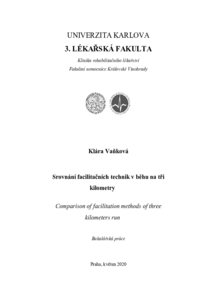Srovnání facilitačních technik v běhu na tři kilometry
Comparison of facilitation methods in three kilometers run
bachelor thesis (DEFENDED)

View/
Permanent link
http://hdl.handle.net/20.500.11956/124039Identifiers
Study Information System: 221625
Collections
- Kvalifikační práce [3377]
Author
Advisor
Referee
Řasová, Kamila
Faculty / Institute
Third Faculty of Medicine
Discipline
Physiotherapy
Department
Department of Rehabilitation Medicine 3FM CU and UHKV
Date of defense
26. 6. 2020
Publisher
Univerzita Karlova, 3. lékařská fakultaLanguage
Czech
Grade
Excellent
Cíl: Záměrem této bakalářské práce bylo přiblížit kinesiotaping a sportovní masáž neprofesionálním sportovcům, především běžcům, a zjistit, zda tyto metody ovlivňují výkon běžce na tříkilometrové trati. Metodika: Měření se zúčastnila skupina 15 zdravých běžců, konkrétně 2 ženy a 13 mužů, ve věku 17-52 let. Pomocí měřících stopek a sportovních hodinek byly získány výsledky zaběhnutých časů, nejprve bez facilitační metody, po druhé s aplikací kinesiotapu na m. rectus femoris a naposled po provedení pohotovostní masáže. Na vyhodnocení dat byl použit Studentův párový t-test. Výsledky: Na hladině významnosti 5% můžeme tvrdit, že masáž před výkonem zlepšil čas běžce na tříkilometrové trati (p-hodnota = 0,00833). Zlepšení po aplikaci kinesiotapu potvrdit nemůžeme (p-hodnota = 0,10861), přestože měli běžci na trati, stejně jako po provedení masáže, většinou časy lepší ve srovnání s časy bez aplikace facilitační metody. Závěr: Obě dvě metody, masáž i kinesiotaping, jsou dnes nezbytnou součástí přípravy profesionálních sportovců. V této práci jsme prokázali účinek pohotovostní masáže DKK, ale ke každému sportovci je nutné přistupovat individuálně, je tedy důležité vyzkoušet, která metoda dotyčnému nejvíce vyhovuje. Klíčová slova: Běh, Sportovní masáž, Kinesiotaping, Výkon
The main objective: The main objective of this bachelor thesis was to present information about kinesiotaping and sport massage to unprofessional athletes, primarily to runners. The next goal was to find out if any of these methods have positive effect on performance on three kilometers run. Methodology: A group of 15 healthy runners have joined the study, age from 17 to 52. With using stopwatches and sport-watches were the results of elapsed time recorded. At first without any of these methods, by the next testing we use kinesiotaping on m. rectus femoris and by the final testing we performed a massage of the lower limbs before performance. The data were evaluated by Student's paired t-test. Results: At the level of 5%, we can say, that massage before performance has positive effect on three kilometers run (p-value = 0,00833). In contrary we cannot confirm the improvement after kinesiotaping application (p-value = 0,10861), although most of the runner got faster on the track in compare to the times of the run without facilitation. Conclusion: Both methods, massage and kinesiotaping, are today necessary part of professional athletes training. In this bachelor thesis we declared positive effect of massage before performance. However each athlete suits different methods, so it is important to have...
